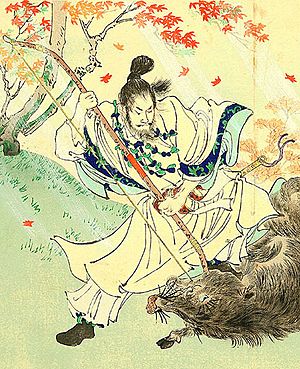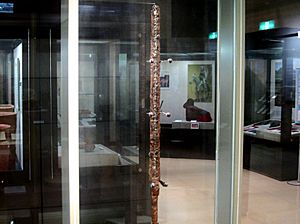Emperor Yūryaku facts for kids
Quick facts for kids Emperor Yūryaku雄略天皇 |
|||||
|---|---|---|---|---|---|

Woodblock print of Yūryaku by Adachi Ginkō, 1896
|
|||||
| Emperor of Japan | |||||
| Reign | 25 December 456 – 8 September 479 (traditional) | ||||
| Predecessor | Ankō | ||||
| Successor | Seinei | ||||
| Born | 418 | ||||
| Died | September 8, 479 (aged 60–61) Hatsuse no Asakura Palace |
||||
| Burial | Tajihi no Takawashi-no-hara no misasagi (丹比高鷲原陵) (Habikino, Osaka) | ||||
| Spouse | Kusaka-no-hatabihime | ||||
| Issue among others... |
Emperor Seinei | ||||
|
|||||
| Father | Emperor Ingyō | ||||
| Mother | Oshisaka no Ōnakatsuhime | ||||
Emperor Yūryaku (雄略天皇, Yūryaku-tennō) (418 – 8 September 479) was the 21st legendary Emperor of Japan. He is known for supporting sericulture, which is the raising of silkworms to produce silk.
We don't have exact dates for his life or when he ruled. But people usually say he was Emperor from December 25, 456, to September 8, 479.
Contents
Who Was Emperor Yūryaku?
Yūryaku was a ruler in the 5th century. His birth name was Prince Ōhatsuse Wakatake (大泊瀬幼武). This means "Young Warrior of Great Hatsuse." Hatsuse was an old name for a place called Sakurai, Nara. The name "Yūryaku" was given to him much later, after his death. It means "Magnificent Plan."
He was the fifth and youngest son of Emperor Ingyō. After his older brother, Emperor Ankō, was killed, Yūryaku fought his other brothers. He won and became the new Emperor.
During his time, the ruler's title was not tennō (Emperor). It was likely Sumera-mikoto or Ame-no-shita Shiroshi-mesu Ōkimi (治天下大王). This means "the great king who rules all under heaven."
Family Life and Children
Emperor Yūryaku had three wives. His main wife was Princess Kusaka-no-hatabihime. His son, Prince Shiraka, later became Emperor Seinei.
Here are his known consorts and children:
- Empress (Kōgō) : Princess Kusaka-no-hatabihime (草香幡梭姫皇女), daughter of Emperor Nintoku
- Consort (Hi) : Katsuragi no Karahime (葛城韓媛), daughter of Katsuragi no Tsubura no Ōomi
- Third Son: Prince Shiraka (白髪皇子), who became Emperor Seinei
- Princess Takuhatahime (栲幡姫皇女, d.459), a Saiō (a special priestess)
- Consort (Hi): Kibi no Wakahime (吉備稚媛, d.479), daughter of Kibi no Kamitsumichi no omi
- Prince Iwaki (磐城皇子, d.479/81)
- Prince Hoshikawa no Wakamiya (星川稚宮皇子, d.479)
- Consort (Hi) : Wani no ominagimi (和珥童女君), daughter of Kasuga no Wani no omi Fukame
- Princess Kasuga no Ōiratsume (春日大娘皇女), who married Emperor Ninken
Stories About Yūryaku
One famous story about Emperor Yūryaku is from the year 463. He invited the thunder god from Mimuro hill to his palace. He sent a messenger named Sugaru to bring the god. Sugaru thought the god would come and rode with a special halberd (a type of spear) to show he was a royal messenger.
Soon, thunder struck. Sugaru asked priests to help put the god into a portable carriage. The god appeared as a huge serpent. But the Emperor didn't do the proper cleaning rituals. The thunder god showed his anger with loud thunder and fiery eyes. Emperor Yūryaku got scared and ran inside the palace. The great serpent was returned to Mimuro. The Emperor then made many offerings to calm the angry god. This story is found in the Nihon Shoki, an old Japanese history book.
Emperor Yūryaku and King Bu
Some historians believe Emperor Yūryaku is the same person as "King Bu" (武) mentioned in old Chinese records. These records, like the Book of Song, say that King Bu from Japan sent messengers to China in 477 and 478. The messages said that the previous ruler, his older brother, had died and Bu had become king.
The character "Bu" (武) is found in Emperor Yūryaku's lifetime name: Ōhatsuse Wakatakeru no Mikoto (大泊瀬幼武尊). This connection is also supported by writings found on ancient Japanese swords, like the Inariyama Sword and the Eta Funayama Sword.
Chinese history books say that King Bu started ruling before 477. He was recognized as the ruler of Japan by several Chinese dynasties. He continued to rule until 502.
His Love for Poetry
Emperor Yūryaku was very interested in poetry. Many poems are believed to have been written by him. Some of his poems are included in the Man'yōshū, a famous collection of Japanese poems. You can also find his verses in the Kojiki and the Nihon Shoki.
Where is He Buried?
The exact place where Emperor Yūryaku is buried is not known today. However, he is honored at a special Shinto shrine called a misasagi in Habikino, Osaka. This place is officially recognized as his mausoleum (burial site) by the Imperial Household Agency. Its formal name is Tajihi no Takawashi-no-hara no misasagi.
See also
 In Spanish: Yūryaku Tennō para niños
In Spanish: Yūryaku Tennō para niños
- Emperor of Japan
- List of Emperors of Japan
- Eta Funayama Sword
- Five kings of Wa
- Imperial cult
- Inariyama Sword


